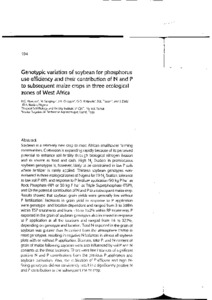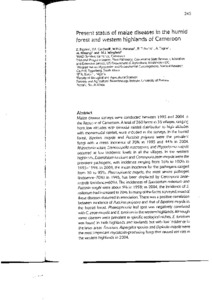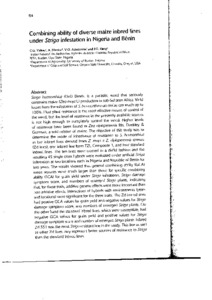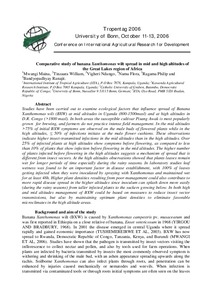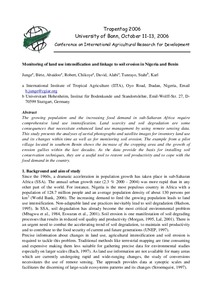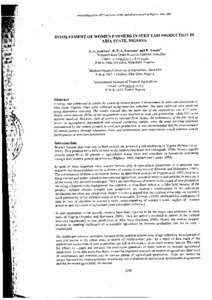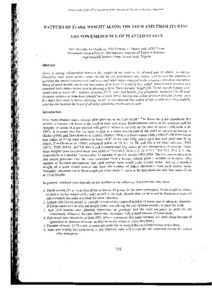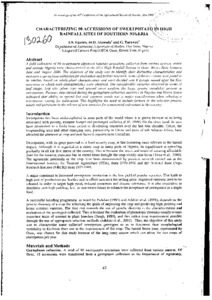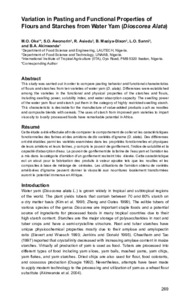Welcome to the International Institute of Tropical Agriculture Research Repository
Conference Documents: Recent submissions
Now showing items 601-620 of 726
-
Maize research at IAR Samaru
(2007)Maize (Zea mays L) research at the Institute for Agricultural Research (IAR), Samaru was initiated in the 1950s with the goal of developing adapted high yielding varieties and hybrids. Germplasm materials were collected from local sources as well as from different countries, including Columbia, Kenya, Mexico and the US' By the 1960s. IAR Samaru was actively participating in the National cooperative Trials, the West African Maize Variety Trials of the OAU-STRC Joint Project as well as the East ... -
Risk aversion and sustainable maize production in Nigeria: some challenges and prospects for agricultural and economic development
(2007)This paper determines the degree or extent of farmer’s risk aversion that affects sustainable maize production in Northern Nigeria. Using a ridge regression analysis, a measure of risk aversion was derived for each individual farmer in a model of safety-first behaviour from a cross-sectional survey of 350 maize producers in northern Nigeria. The distribution of the degree of risk aversion shows a high skewness towards the risk averters (high risk farmers) and centered around 1.20, and standard ... -
Genotypic variation of soybean for phosphorus use efficiency and their contribution of N and P to subsequent maize crops in three ecological zones of West Africa
(2007)Soybean is a relatively new crop to most African smallholder farming communities. Cultivation is expanding rapidly because of its perceived potential to enhance soil fertility through biological nitrogen fixation and its source as food and cash. High N2, fixation in promiscuous soybean genotypes is, however, likely to be constrained in low P soils where fertilizer is rarely applied. Thirteen soybean genotypes were evaluated in three ecological zones of Nigeria for (1) N2, fixation, tolerance to ... -
Present status of maize diseases in the humid forest and western highlands of Cameroon
(2007)Maize disease surveys were conducted between 1995 and 2004 inthe Republic of Cameroon. A total of 260 farms in 36 villages, ranging from low altitudes with bimodal rainfall distribution to high altitudes with monomodal rainfall, were included in the surveys. ln the humidforest, Bipolaris maydis and Puccinio polysora were the prevalent fungi with a mean incidence of 70% in 1995 and 44% in 2004. Rhizoctonia solani, Stenocarpella mocrospora, and Physodermo maydisoccurred at low incidence levels in ... -
Colonization of resistant and susceptible maize genotypes by the pink stem borer, Sesamia calamistis (Lepidoptera: Noctuidae)
(2007)The role of four colonizing responses (oviposition, larval arrest, larval establishment and larval feeding) of Sesamia calamistis (Lepidoptera:Noctuidae) in determining the resistance or susceptibility of eight genotypes of maize Zea mays L.) was elucidated. Four resistant (S59-1, 55 1 1-1, 55 27-1 and 55 27-9, two moderately resistant Tzmi 103 and Tzi 4001), and two susceptible 65 20-2 and Tzmi 407) genotypes were used in the study. S. calamistis exhibited variable colonizing responses on the ... -
Genetic analysis of drought tolerance in maize inbred lines: preliminary results
(2007)Drought stress causes significant yield reduction in maize Zea mays L. grown in sub-Saharan Africa (SSA. An understanding of the inheritance of drought tolerance would be useful in developing drought tolerant hybrids. The objectives of this study were to determine (i) the effects of the level of drought tolerance in parental inbred lines on the performance of their hybrids, (ii) mode of inheritance of drought tolerance in inbred lines selected for contrasting responses to drought, and (iii) ... -
Combining ability of diverse maize inbred lines under Striga infestation in Nigeria and Benin
(2007)Striga hermonthica (Del.) Benth. is a parasitic weed that seriously constrains maize (Zea mays L) production in sub-Saharan Africa. Yield losses from the infestation of S. hermonthica on maize can reach up to 100%. Host plant resistance is the most effective means of control of the weed, but the level of resistance in the presently available sources is not high enough to completely control the weed. Higher levels of resistance have been found in Zea diploperennis lltis, Doebley & Guzman, a wild ... -
Adoption of improved cassava varieties in Uganda: implications for agricultural research and technology dissemination
(2007)Improved germplasm from the cassava-breeding program has generated new varieties that are increasingly being grown by farmers in Uganda.In this study, the socio-economic and demographic characteristics of cassava farmers in different regions of Uganda, adopted cassava varieties, their adoption rates, desirable and undesirable attributes, and factors that have influenced the speed of adoption of the most adopted variety were determined. ... -
Comparative study of banana Xanthomonas wilt spread in mid and high altitudes of the Great Lakes region of Africa
(2006)Studies have been carried out to examine ecological factors that influence spread of Banana Xanthomonas wilt (BXW) at mid altitudes in Uganda (800-1500masl) and at high altitudes in D.R. Congo (>1800 masl). In both areas the susceptible cultivar Pisang Awak is most popularly grown for brewing, and farmers do not practice intense field management. In the mid altitudes >75% of initial BXW symptoms are observed on the male buds of flowered plants while in the high altitudes, ≤50% of infections initiate ... -
Monitoring of land use intensification and linkage to soil erosion in Nigeria and Benin
(2006)The growing population and the increasing food demand in sub-Saharan Africa require comprehensive land use intensification. Land scarcity and soil degradation are some consequences that necessitate enhanced land use management by using remote sensing data. This study presents the analyses of aerial photographs and satellite images for inventory land use and its changes within time as well as for monitoring soil erosion. The example from a pilot village located in southern Benin shows the increase ... -
Involvement of women farmers in seed yam production in Abia state, Nigeria
(2006)A survey was conducted to assess the extent of women farmer's involvement in seed yam production in Abia State, Nigeria. Data were collected using intensive, schedule. The data collected were analysed using descriptive statistic. The results show that the mean age of the respondents was 47.7 years. Ninety seven percent 97% of the respondents were involved in seed yam production. While 93% were actively involved. However, lack of access to relevant farm inputs, the tediousness of the job, lack of ... -
Pattern of stake weight along the stem axis from its base and non emergence of planted stakes
(2006)There is strong relationship between the weight of stake to be planted and it ability to emerge. Therefore, only good quality stem should be cut, partitioned into stakes, and treated for planting to optimise the limited resource of land area and other input engaged in the cassava cultivation enterprise. Stems of good health can cut into stake of at least 50gm, and if they satisfy severe other features of a standard stake before being used in planting a field. These includes: length (20-25cm), age ... -
Standard stake yield of 43 CMD cassava genotypes in 11 locations of Nigeria: implications for stem supply systems
(2006)Standard stake yield (SSY) was estimated using data from multi-locational trials in 11 locations. These were: Onne, Obrikom, Warri, Obayantor, Umudike, Nanka, Akure, Ajibode, Ibadan, and Zaria during 2003-2005 season. The aim was to identify location suitable for stem production and also to estimate the quantity of standard stakes obtainable per plant for all the 43 IITA- CMA resistant genotypes. Stakes of 25cm long cut from matured healthy plant were planted at 1mx1m on flat or ridges. No fertilizer ... -
Determination of micronutrients and colour variability among new plantain and banana hybrids flour
(2006)Quantitative colour variability and micronutrient content of new plantain and banana hybrids flour was investigated. The mean flour colour of the cultivars ranges from 12.16 for BITA 3 to 18.52 for FHIA 23, which is an indication of varying degree of yellowness. Both FHIA 23 and PITA 17 had colour value higher than the general sample means. Agbagba contained the highest level of iron (36.5 µg g ), which is higher than 1the overall sample means, followed by FHIA 17 (16.135 µg g ). The rest of the ... -
Evaluation of 5 hybrid yams for dry season yam production in lowland areas
(2006)A two year trial was conducted at the inland valley of the National Root Crop Research Institute, Umudike during the dry season of 2003/2004 and 2004/2005. The purpose was to evaluate the suitability of five hybrid yam clones of dry season yam production. The yams were planted in manually made ridges and laid out in RCB design in three replicates. Fresh yam tuber yield 22.6t/ha; 21.8t/ha: 19.1 t/ha and 18.1 t/ha were respectively achieved from TDr 95/18949: Tdr 97/00925; TDr 03/00193 and TDR ... -
Characterizing 90 accessions of sweetpotato in high rainfall sites of southern Nigeria
(2006)A field collection of 90 sweetpotato (lpomoea batatas) accession collected. from various sources within and outside Nigeria were characterized at the llTA High Rainfall Station in Onne, Rivers State between June and August 2006. The objective of the study was to identify their distinctive characteristics and mountain of germplasm collection for evaluation and further research. Some of the accessions were found to be similar, based on whole-plant characteristics and were divided into 8 groups named ... -
Variation in pasting and functional properties of flours and starches from water yam (Dioscorea alata)
(2009)This study was carried out in order to compare pasting behavior and functional characteristics of flours and starches from ten varieties of water yam (D. alata). Differences were established among the arieties in the functional and physical properties of the starches and flours, including swelling power, solubility index, and water absorption capacity. The swelling power of the water yam flour and starch put them in the category of highly restricted swelling starch. This characteristic ...




